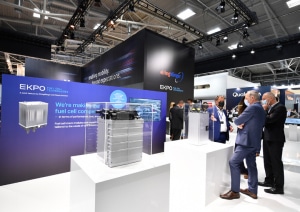The joint venture between ElringKlinger and Plastic Omnium has built up a production capacity of 10,000 stack units per year at the Dettingen site. According to chief finance officer Dr. Gernot Stellberger, the fuel cell manufacturer from Baden-Württemberg has a lead of about two years over the competition in the area of industrial stack design. The company is aiming for a sales revenue of up to one billion euros by the end of the decade. In addition to the commercial vehicle sector, there is great interest from the maritime and rail industry. In the joint venture Aerostack with Airbus, EKPO Fuel Cell Technologies GmbH is developing a stack for use in aviation.
According to Dr. Gernot Stellberger’s analysis, the first step in the commercialization of fuel cells in the mobile sector will not be taken with passenger cars. “We are currently registering very strong interest in the light and heavy freight transport sector, in trains and in maritime solutions,” said the EKPO chief finance manager. The joint venture between the German and French automotive suppliers was established in October 2020 and commenced operations at the beginning of March 2021. Due to the majority shareholding structure, where ElringKlinger holds 60 percent and Plastic Omnium 40 percent, the company is consolidated within the ElringKlinger Group.
According to Stellberger, who previously led the Global Strategy, M&A and Innovations division at ElringKlinger, the dynamics in the market have increased strongly. “We receive an average of ten to twelve new requests per month. We almost can’t keep up processing them with the same high quality.” These are mainly pilot- or prototype-driven projects, reports the CFO. Many companies are now approaching the topic of hydrogen. This confirms the expectations of the company headquartered in Dettingen an der Erms that hydrogen will be a major topic in mobility in the future.
As Gernot Stellberger reports, the momentum of FC technology is being felt everywhere, both on the customer and supplier sides. He describes the current situation so: “The companies take stock of their situation and try out adequate solutions for the respective needs. And this is done in test fleets of maybe ten vehicles here, twenty there.” This way, they’ve been able to speak with nearly all the significant commercial vehicle manufacturers and can say that these have pursued a hydrogen agenda.[…]
… Read this article to the end in the latest H2-International
Author: Michael Nallinger

























0 Comments